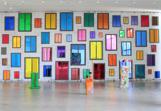
Open arms to art and its development
It always feels special to go to cities where major museums are free (OK, for a donation)—there’s something so egalitarian and sophisticated about places that support both art and access. Of course, most museums are on shoe-string budgets,
and in economic hard times like these, that’s a luxury that institutions can’t afford (and Miami’s museums are both affordable and some of them free on certain days, see below). But private collections are another matter, which is why the year-old de la Cruz Collection space is such a joy—the fact that it is free and regularly open says a lot about its owners. That the de la Cruzes want to be interactive with the community and support its cultural development is clear.
And in addition, this month (and since Art Basel), the space is highlighting local video work in two separate spaces—that says even more.
Walking in, the space designed by John Marquette feels open; there’s a certain work-in-progress element to it all, which is OK too, as it reflects a living space and not mausoleum. Intentionally or not, one of the best installations currently on the first floor is about openness and light; a wall of colored mirrors that look like windows, from Ugo Rondinone. Look closely at the background wallpaper, a reference to another aspect we think helps keep a society open and free (that product that is black and white and used to be read all over). The installation is part of the 2011 show, loosely based on versions of Surrealism after a portrait by Salvador Dali of Carlos de la Cruz’s mother. The Cuban artists so close to Rosa de la Cruz’s heart are still on view too, such as Felix Gonzales-Torres and Ana Mendieta.
But on to the local.
On the ground floor project room is a video from Christy Gast, who shows with Gallery Diet. Herbert Hoover Dyke (yes, the spelling of the last word is intentional) is a musical exploration of the landscape. The artist is filmed tap-dancing her way, alone and wearing a tuxedo and cowboy hat, around the dike that holds Lake Okeechobee in. Dikes, like dams, are ugly barriers imposed on our planet by humans wanting to control the ebb and flow of life. And yet, before that dike, thousands of lives were destroyed when the massive lake overflowed—it’s a structure we’ve had to come to terms with. So Gast dances along it, under a broad Florida sky, tapping out an “assortment of rhythms on a ribbon of crunching gravel and asphalt, plinking steel grates and barrier gates, reverberating water tanks and a confounding array of limestone columns jutting from the slope … through a not-quite natural landscape,” as the release describes the scene she creates. The screen itself is slanted, sloping like the dike, in the project space, becoming a sculpture on its own.
Upstairs, more single-channel videos from local artists are unspooling as well, curated by Carlos Rigau. In a darkened room, behind some neon-light frames, six shorts are on loop, mostly depicting some fairly mundane actions by a protagonist—jogging through night-time city streets, or swimming (albeit with a creepy inflatable horse); some were entries in last year’s Optic Nerve at MOCA.
It’s good that all of this has such a nice home, welcoming to all.
The de la Cruz Collection, 23 N.E. 41st St., Miami; www.delacruzcollection.org; open Tuesday through Saturday.
Also free, MAM on every second saturday of the month; and the Wolfsonian-FIU is free after 6 p.m. on Fridays. Other museums have special days throughout the year, so check in on them.
Recent Content
-
Artsarticle ·
-
Artsarticle ·
-
Artsarticle ·

